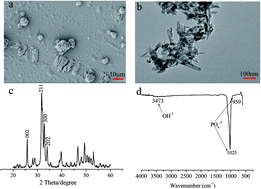Nanohydroxyapatite/cellulose nanocrystals/silk fibroin ternary scaffolds for rat calvarial defect regeneration†
Abstract
The purpose of this study was to design and characterise a novel biomimetic scaffold for the repair of critical size calvarial defects. In this study, we developed a new hydroxyapatite/cellulose nanocrystals/silk fibroin (HA/CNC/SF) scaffold by mixing a solution of SF with HA and CNC nanoparticles. The scaffold was fabricated by freeze-drying. The average pore size and porosity of the HA/CNC/SF scaffolds were 110 ± 7.3 μm and 90 ± 6.2%, respectively. The thermostability and mechanical properties of the scaffolds were significantly better than those of either SF, CNC/SF or HA/SF scaffolds. Additionally, the composite scaffold exhibited excellent biocompatibility and superior osteoconductivity. Hence, the efficacy of the HA/CNC/SF scaffold was evaluated for bone regeneration in the rat calvarial defect model. The results demonstrated that the rat calvarial defect healed with new-formed bone within 12 weeks of implantation and the degradation rate of the scaffold was a good match to the bone regeneration rate. Therefore, the HA/CNC/SF scaffold is considered to be a strong candidate for the repair of bone defects in bone tissue engineering.


 Please wait while we load your content...
Please wait while we load your content...